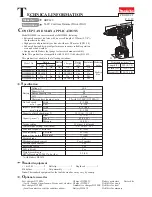
Checking the Coolant Level
in the Radiator
Service Interval:
Every 50 hours
WARNING
If the engine has been running, the radiator
will be pressurized and the coolant inside will
be hot. If you remove the cap, coolant may
spray out, causing severe burns.
•
Do not remove the radiator cap to check
coolant levels.
•
Do not remove the radiator cap when the
engine is hot. Allow the engine to cool for
at least 15 minutes or until the radiator cap
is cool enough to touch without burning
your hand.
Note:
The cooling system is filled with a 50/50
solution of water and ethylene-glycol antifreeze.
1.
Move the machine to a level surface, shut off
the engine, and remove the key.
2.
Allow the engine to cool.
3.
Open the front and rear hood.
4.
Remove the radiator cap from the filler neck of
the radiator and check the coolant level (
and
Note:
The coolant should be up to the filler
neck.
g220074
Figure 105
1.
Radiator cap
2.
Reservoir
5.
If the coolant level is low, add coolant until the
level is up to the bottom of the filler neck (
Important:
Do not overfill the radiator.
Note:
If the radiator coolant level is low and the
coolant reservoir level is at the Full mark, check
for air leaks in the hose between the radiator
and the coolant reservoir.
6.
Install the radiator filler cap, ensuring that it is
tightly sealed (
).
7.
If the air temperature is below 0°C (32°F), mix
the ethylene glycol and water completely by
running the engine at operating temperature for
5 minutes.
Checking the Condition
of the Cooling-System
Components
Service Interval:
Every 400 hours/Yearly (whichever
comes first)
Check the condition of the cooling system for leaks,
damage, dirt, and loose hoses and clamps. Clean,
repair, tighten, and replace the components as
necessary.
Checking the
Concentration of the
Coolant
Service Interval:
Every 800 hours/Yearly
(whichever comes first)—Check the
concentration of the coolant before
the winter season.
Test the concentration of ethylene glycol-based
antifreeze in the coolant. Ensure that the coolant
has a 50% ethylene glycol and 50% water mixture or
equivalent.
Note:
A 50% ethylene glycol and 50% distilled water
mixture will protect the engine to -37° C (-34° F)
throughout the year.
Using a concentration tester, check the concentration
of the coolant mixture to ensure that it is 50% ethylene
glycol and 50% distilled water or equivalent; refer to
the manufacturer’s instructions for testing.
86
Summary of Contents for 2226
Page 107: ...Notes ...
Page 108: ......
















































